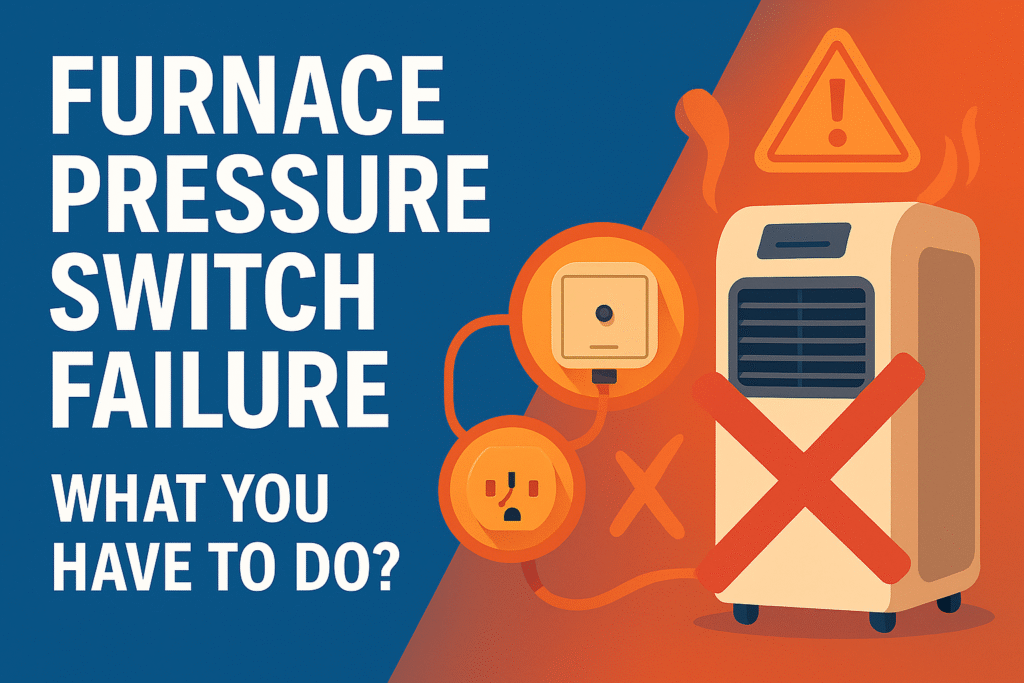When winter sets in across Canada, the last thing any homeowner wants is a heating system that suddenly stops working. One of the most overlooked causes of furnace malfunction is a furnace pressure switch failure. Though small, this switch plays a vital role in the operation of your furnace, acting as a safety guard to prevent unsafe ignition.
In this detailed guide, we’ll break down everything you need to know about furnace pressure switch failure, including what it is, how it works, signs of failure, troubleshooting tips, and when to call professionals like GM Heating and Cooling Inc.
What is it?
A furnace pressure switch failure refers to a malfunction in the device that verifies whether the furnace’s inducer fan is creating proper airflow through the vent system. This switch ensures that combustion gases are safely vented outdoors before the burners are ignited. When it fails, the furnace either won’t start or will shut off prematurely.
Without a properly functioning pressure switch, your furnace may stop working entirely or become a safety hazard.
How it works
The pressure switch sits near the inducer motor and contains a diaphragm that responds to pressure changes. When the inducer motor turns on, it draws air through the heat exchanger, creating a pressure drop. This causes the diaphragm to activate, signaling to the control board that it’s safe to ignite the burners.
In a furnace pressure switch failure, the switch may fail to close or stay stuck open, interrupting the furnace’s startup process.
Warning signs
Early detection of a furnace pressure switch failure is crucial for avoiding costly repairs. Watch for these common symptoms:
- The furnace won’t start
- The blower runs, but no heat
- Furnace short cycling
- Error codes flashing on the control board
- Clicking sounds near the inducer motor
- Cold or lukewarm air blowing from vents
If you experience any of these, you may be dealing with a furnace pressure switch failure.
Common causes
Several issues can lead to a furnace pressure switch failure. Let’s take a look at the most frequent causes:
1. Blocked or restricted vents
Outdoor furnace vents can become clogged with snow, leaves, or nests. This blockage prevents proper airflow, causing the pressure switch to remain open.
2. Cracked or clogged hose
The hose connecting the switch to the inducer can crack or collect moisture, interrupting air pressure signals.
3. Electrical malfunctions
Loose wiring, corroded connectors, or voltage fluctuations can cause the pressure switch to fail or misfire.
4. Worn or faulty switch
Over time, the diaphragm inside the switch wears out. Aged components often result in unreliable readings.
5. Inducer motor issues
If the inducer fan fails to create sufficient airflow, the pressure switch may not activate correctly.
6. Negative home pressure
Tightly sealed homes or powerful exhaust fans may create negative indoor air pressure, interfering with furnace airflow.
Supporting keywords: furnace not igniting, clogged vent pipe furnace, pressure switch stuck open, inducer motor failure.
Troubleshooting tips
Before calling a professional, try these troubleshooting steps to diagnose a furnace pressure switch failure:
Step 1: Turn off the power
Always shut off the power to the furnace before inspection.
Step 2: Check exterior vents
Go outside and remove snow, debris, or pests from intake and exhaust pipes.
Step 3: Inspect the hose
Remove the pressure switch hose and check for water, dust, or cracks.
Step 4: Use a multimeter
Test for continuity across the switch terminals. A faulty switch won’t show proper readings.
Step 5: Reset the furnace
After cleaning or inspecting, restore power and attempt a furnace restart.
If the furnace still doesn’t ignite, contact GM Heating and Cooling Inc. to schedule a professional diagnosis.
When to call GM Heating and Cooling Inc
If basic troubleshooting doesn’t resolve the furnace pressure switch failure, or if you’re uncomfortable testing components, call the experts at GM Heating and Cooling Inc. Their certified technicians will:
- Accurately diagnose pressure switch failure
- Identify underlying airflow or electrical issues
- Repair or replace faulty components
With decades of HVAC experience in Canadian climates, GM Heating and Cooling Inc. provides prompt, reliable service to keep your home warm and safe.
How to prevent it
Regular maintenance is key to avoiding a furnace pressure switch failure. Here’s how:
- Schedule annual furnace inspections
- Clear outdoor vents regularly
- Replace filters every 1–3 months
- Check for moisture in hoses
- Use surge protectors to guard electronics
Preventive care not only extends the life of your furnace but ensures that the pressure switch remains reliable.
Replacement cost in Canada
The cost to replace a furnace pressure switch in Canada typically ranges from $150 to $350, including parts and labor. Prices may vary based on furnace model and emergency service charges.
Replacing the switch proactively can help avoid total system breakdowns and restore furnace reliability.
Rebates and incentives
Depending on your province, government programs may offer rebates for furnace upgrades or energy-efficient HVAC systems. In Ontario and British Columbia, for example, homeowners may receive rebates for installing high-efficiency furnaces or making energy-efficient repairs.
Ask GM Heating and Cooling Inc. about available rebates and how fixing a furnace pressure switch failure can help you qualify.
Final thoughts
A furnace pressure switch failure can stop your heating system in its tracks, especially when you need it most. Knowing the warning signs, causes, and solutions can save time and money, and keep your home safe and warm during Canadian winters.
If you’re unsure or need expert help, don’t hesitate to reach out to GM Heating and Cooling Inc. Their professional technicians are equipped to handle all furnace issues, including diagnosing and fixing a furnace pressure switch failure.
Stay warm, stay safe, and act early when you suspect furnace trouble!


